



Introduced: 2005 (Model Power version), 2012 (Micro-Trains version) and 2017 (MRC version)
This was the third model in the Ajin / Model Power line of steam locomotives. Said line also includes a 4-6-2 Pacific, a 2-8-2 Mikado and a 2-6-0 Mogul (note that the 2-6-0 and 4-4-0 share the exact same locomotive and tender shells). All of them have nice looking, finely detailed metal shells. Similarly, they all share many of the same basic internal design characteristics. And unfortunately, the entire line is (for the most part) a hugely mixed bag in terms of their quality. In fact, due to various defects, the initial 2005 production run of this particular locomotive was actually recalled by Model Power and shipped back to Ajin for repairs.
A second/revised version of this model was released in 2012 (sold exclusively by Micro-Trains). These were only available in three different road names - B&O (as part of weathered car/loco set #99301180), ATSF (as part of loco/caboose set #99321121), and Ringling Bros (#98500701).
Model Power went out of business in 2014 and was subsequently acquired by MRC. In 2017, MRC released revised versions of these models (still in the old Model Power packaging, but with MRC mentioned on the box). These new models are a considerable upgrade over the previous versions (and available with DCC-Sound), but before we discuss those let's first take a look at the older ones.
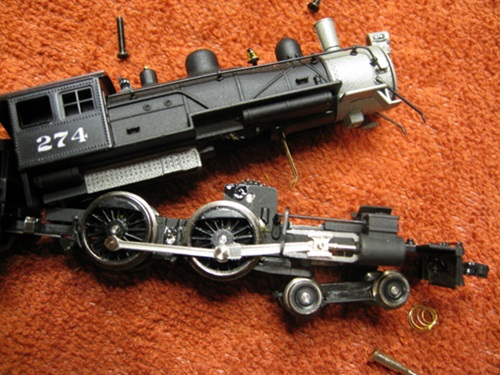
The shell and mechanism are a total Chinese puzzle box of interconnected parts and, as a consequence, pretty difficult to disassemble. To separate the boiler shell from the chassis, you first have to unscrew the pilot truck screw and the rearmost screw on the driver bottom-plate. The boiler section should separate from the chassis at this point (just give it a bit of a tug to free the central gear tower from the shell). However, since there are wires running from the drawbar to the driver wipers and motor, you won't be able to move the shell very far.
The motor, flywheel, driveshaft, worm and headlight all live up inside the boiler. To access the motor (and beyond) you first need to remove the cab (spread the sides apart and it should pop off). Next, you need to remove the boiler backplate "detail" (free the two side clips from the shell). The motor and worm should slide out of the back of the boiler at that point (in theory, anyway - I've never actually tried).
The chassis and shell are both metal. The motor is a 5-pole Mashima. And as alluded to above, the driveshaft includes a flywheel. Both sets of drivers are geared, and with the exception of the brass worm, all gearing is plastic. A non-directional headlight is mounted inside the boiler. Current reaches the headlight by way of long metal contacts that extend all the way down to the driver wipers. Said contacts are extremely difficult to get realigned (IE, back in contact) if you ever have to remove the driver bottom-plate. There is no backup light in the tender.
The pilot coupler is an operational (albeit non-automatic) knuckle. The tender coupler varies by version - the Model Power version has a truck-mounted Rapido-style coupler, whereas the Micro-Trains version has a chassis-mounted Micro-Trains coupler. The drawbar is plastic, permanantly held in place on either end, and absolutely full of wires. All wheels are blackened and low-profile (no problems on Code-55 rails).
There were no traction tires on the first version, so pickup is provided by all four drivers (via vertical wheelback wipers). The pilot truck is electrically neutral. Four of the eight tender wheels provide pickup as well. Unfortunately, current is transferred into the tender by way of flimsy axle wipers (an archaic and notoriously unreliable scheme).

The MTL version has traction tires on the rear set of drivers. The driver wipers were changed over to being horizontally oriented. To compensate for the lost driver pickup caused by the traction tires, forward extensions were added to the driver wipers in order to conduct current from the rear wheels of the pilot truck. Four-wheel tender pickup is still provided by axle wipers, however said wipers were changed to stiff metal wires (providing better conductivity and less drag) -
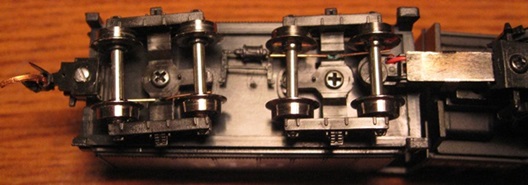

Although there is no simple "drop in" decoder option for these models, they are at least "DCC Friendly". What Ajin has done is provided color-coded DCC wiring leads in the tender for pickup and motor control (sadly, there is no wiring for headlight control). So, no, not a simple plug'n'play decoder install. But still, about as painless as it gets otherwise. The tender shell is held on via simple friction and pulls off with minimal effort -
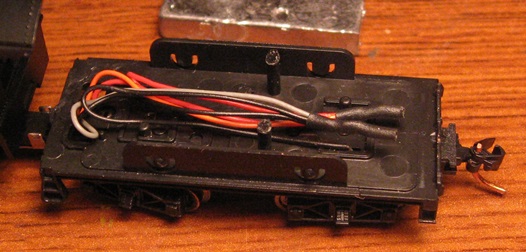
The basic mechanism on the first version runs smoothly and quietly (no binding or shimmying or weird noises or anything like that). And overall, these 4-4-0's do tend to run better than the previous 2-8-2 and 4-6-2 models. Unfortunately, you still have those axle wipers on the tender to contend with. And as we all know, flimsy metal wipers (be they on axles or behind drivers) are a pain in the ass - they like to lose contact over time, they love to collect all manner of gunk and crud, and they're very difficult to clean. So really, it's just a matter of time before pickup starts to go south on these things.
Pickup issues aside though, the real problem with the first version is its pulling power (or lack thereof). Given the overall light weight (not to mention the lack of traction tires), mine can't pull more than about 5-6 freight cars on level track (and perhaps half that on a grade). Fortunately, one can improve overall performance significantly by replacing the primitive tender trucks with low-friction / all-wheels-live Kato or Bachmann tender trucks. Once so modified, my 4-4-0 ran quite smoothly and was able to comfortably pull fifteen 40' freight cars on level track.
Performance on the MTL version is significantly better than on the original Model Power version. Mine runs very smoothly and quietly, and given the traction tires and the revised tender wipers, it can pull as many as twenty 40' freight cars on level track (and although I haven't actually tried, one would assume that applying the aforementioned tender truck modification would allow it to pull even more). On the downside, Ajin quality control still appears to be all over the map as I had to buy two of the ATSF loco/caboose sets before I got one that ran well. The first one had a broken pilot coupler and made all sorts of annoying squeaking sounds as it rolled along (even after applying lubrication). So, once again, be prepared to buy/return several of these in order to get a good one.
As noted above, MRC released improved versions of these models in 2017. And the really good news is that the pickup on the tender trucks was completely redesigned. As you can see, gone are the axle wipers (replaced instead by needlepoint axle / dimpled wiper cup pickup on all eight wheels) -
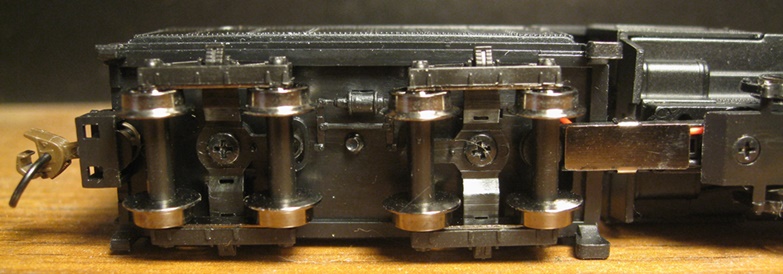
Internally, the gearing was changed over to the same greyish looking plastic used by Ajin on their revised 2-8-2 and 4-6-2 models. Oddly enough, the couplers (both tender and pilot) were changed over to the exact same McHenry-style couplers used by Bachmann on their locomotives of similar vintage. As with the MTL version, the tender coupler is chassis-mounted.

The driver wipers are the same as on the MTL version (IE horizontally oriented). The traction tires were moved to the forward set of drivers. And although said driverset does have its own set of wipers, it seems unlikely that they could provide much in the way of current conductivity. As on the MTL version, the forward driver wipers have extensions that contact the rear wheels on the pilot truck.

As on the revised Mikado and Pacific models, wiring for DCC headlight control was also added to these models. Unfortunately, only one wire (running back to the tender) was added. As pictured below, right-rail current for the headlight still comes from one of those annoying metal contacts running down to the driver pickup -
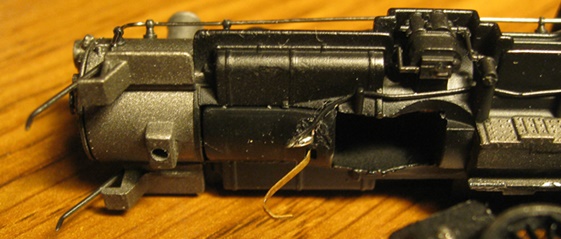
Apart from an extra weight glued inside the shell. nothing much changed inside the tender. On the DCC-Sound models, all they did was connect up an MRC sound decoder to the existing wiring (and with the speaker nestled inside of a foam ring glued to the inside of the shell). I'm told that the decoder is an MRC 1961 (specifically designed for use on these MRC steamers). The tender itself was not modified for sound (IE there aren't any speaker holes in the chassis or anything like that). The sound is somewhat underwhelming to my ear, but since I remain unimpressed by N scale sound in general you're going to have to take my opinions in that regard with a grain of salt.
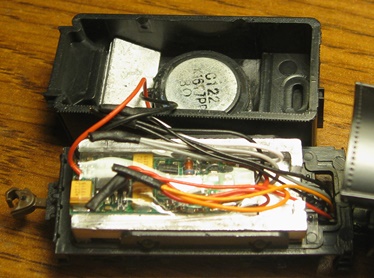
Performance on this MRC version is simply outstanding. Mine runs smoothly and quietly at all throttle levels. Slow speed creep is impressive and the top-end speed is very reasonable. I didn't have any pickup-related issues (stalling, stuttering, etc). No wobbling, shimmying, or binding either. Pulling power is decent (although not quite as strong as on the MTL version), with mine able to handle around 17 assorted freight cars on level track. And although I do still have my reservations about the driver wiper situation, I think the benefits of the new tender pickup scheme should serve to cancel out any potential issues there. Overall, these are gorgeous looking models with performance to match.
In 2019, Heartland Hobby purchased the tooling for the old Model Power line of N scale locomotives from MRC. It's anyone's guess what (if anything) they plan on doing with it, but it's entirely possible that we've seen the last of them.
MRC Features -
- 5-Pole Mashima Motor
- Metal Boiler, Chassis, and Cylinders
- Separatley Applied Metal Handrails
- Golden White LED
- Fly-Wheel Drive
- Traction Tire Factory Installed
- Front/Rear Knuckle Couplers
- Axle Pin Tender Truck Pick-Ups
- LED Wiring To Tender
- Extra Weight in Tender
- Available With Factory Installed DCC & Sound
All of these models are available in a variety of different configurations (with the detailing varying based on the prototype in question) -
- Headlight (Top or Center)
- Pilot (Foot Board or Boiler Tube)
- Cylinder Type (Slide Cylinder or Valve Cylinder)
- Cab Windows (Rectangular or Arched)
- Tender Trucks (Andrews or Arch Bar)
All of the alternate options are supplied ala carte with the undecorated units, allowing you to configure them however you like -
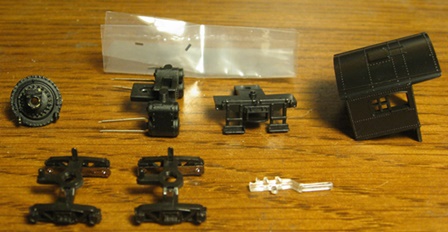
Prototype information -
The 4-4-0 is most commonly known as the "American" type due to the large number that were produced and used in the US. However, it quickly became popular in the UK and was widely produced there as well. The 4-4-0 was gigantic - outperforming many of the strongest locomotives of its time. And although several of its early design elements proved troublesome, subsequent improvements skyrocketed its popularity in the US and abroad. By 1872, 60% of Baldwin's locomotive construction was of this type, and it is estimated that fully 85% of all locomotives in operation in the USA were 4-4-0's. The American was eventually supplanted by larger designs (like the 2-6-0 and 2-8-0), although the 4-4-0 wheel arrangement remained a favorite for express services. The widespread adoption of the 4-6-0 (and larger) locomotives eventually helped seal the 4-4-0's fate as a product of the past.
Grades: C (original Model Power version) and A (MTL and MRC versions)
First version reviewed: 03/06 Model Railroader - ("A nicely proportioned N scale model of a 4-4-0 American type has been released by Model Power. Small steam engines are few and far between in N, and Model Power has high hopes for this one - the American is available in 16 road names plus a painted but unlettered version... Model Power's 4-4-0 performed well on our test track. Our sample started and ran at just under 4 mph; it topped out at roughly 80 mph. Both tender trucks and both drivers pick up current. In testing the locomotive on a flat layout with 9 3/4" curves, I found that a six-car train was about the limit for this engine - not too much of a surprise when you remember that only two axles are doing the pulling.
"The tender body lifts off easily, revealing a small weight on the tender frame and exposing the wiring from the tender-truck axle wipers (one tender truck draws current from one rail, the other truck draws from the other rail). There is enough space in the tender shell to install a small DCC decoder, although the job would require soldering. The Rapido-style coupler and coupler box on the tender pops off, allowing the installation of a Micro-Trains 1025 magnetic coupler. Depending on the road name, Model Power 4-4-0s come with either coal or oil tenders, archbar or Andrews tender trucks, square or arched cab windows, vertical tube or footboard pilots, valve or slide cylinders, and top or center-mounted headlights. The undecorated version comes with an assortment of extra parts to help modelers customize to their own railroad's appearance.
"Our sample was lettered for PRR and numbered 1223, after a real PRR 4-4-0... Although some of the dimensions are in the ballpark, the model doesn't resemble the PRR prototype. It has a different cab and boiler contour, and it lacks Pennsy's distinctive Belpaire firebox. Although its appearance is more generic than specific in some areas, Model Power's 4-4-0 is a nice-running and nicely proportioned model of an iconic American steam locomotive. ATSF, ACL, BO, BM, CN, CBQ, CNW, GN, LI, LN, MSL, NYC, NP, PRR, Southern, SP, Undec. $145")